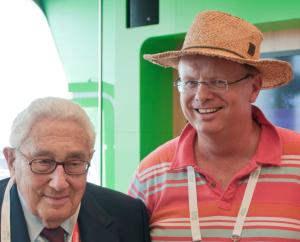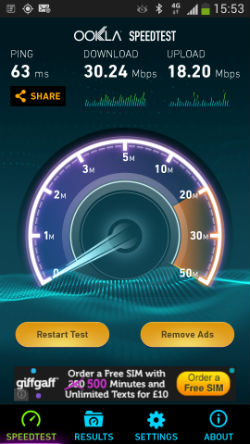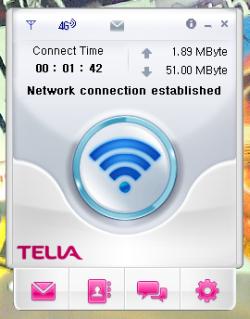 In February I wrote about the O2 4G trials in London. The trials involved travelling around the city with a laptop and a 4G dongle looking for fast mobile internet access. Six months later I was back on holiday in London for the Olympics, billed as the “connected games”. As I was due to spend 8 days out of the Olympic fortnight in and around Olympic venues I thought I’d follow up the earlier 4G exercise with some mobile speed testing.
In February I wrote about the O2 4G trials in London. The trials involved travelling around the city with a laptop and a 4G dongle looking for fast mobile internet access. Six months later I was back on holiday in London for the Olympics, billed as the “connected games”. As I was due to spend 8 days out of the Olympic fortnight in and around Olympic venues I thought I’d follow up the earlier 4G exercise with some mobile speed testing.
Highlights include the Apple Store, Virgin Wifi on platforms on the London Underground, the Cisco House at the Olympic Park and BTOpenzone at the Waldorf Hotel.
To test the 3G and WiFi networks after 4G seems the wrong way round but is still valid. The rise of the WiFi hotspot combined with the continuous increase in mobile data capacity are elements of the new mobile battleground for network operators. You don’t need to be a mobile operator to play. WiFi is strategic for both fixed and mobile players. It’s a competitive play amongst broadband providers and an offload mechanism for mobile players wanting to reduce the load on their cellular data networks
For the tests I used my Samsung Galaxy S3 and a couple of different apps from speedtest.net and thinkbroadband.com. The two apps produced slightly different results but in the great scheme of things were broadly the same – when the connectivity was good they both said it was good.
Rarely can a set of technical tests have been conducted in such interesting and historical surroundings. I started at home in Historic Lincoln on 31st July and did a quick test whilst still in bed at 5.52am getting around 8Mbps down and 400k up using my home broadband (boy am I looking forward to FTTC).
We stayed that night with friends in Historic Windsor. Their WiFi was up and down and the cellular data connection was near to non-existent at 11k down and 85k up.
In the morning of 1st August we were heading for the Millenium Stadium in Cardiff to watch TeamGB beat Uruguay. I jumped on the 15 minutes of The Cloud’s free WiFi at Historic Slough railway station and got a reasonable 5.9Mbps down and 1.6Mbps up. Upload speed is becoming just as important for me as download as I back up all my photos and videos to Google+ and like to post to YouTube.
Interesting that the WiFi at our friends house in Cardiff was a poor 1.6Mbps down but 3Mbps up.  I couldn’t get on the WifI at the Millenium stadium because I needed a BT Logon and being tight I didn’t want to pay for it. However the O2 mobile data connection was absolutely terrific at 7.7Mbps down and 1.5Mbps up. At half time as the 70,000 in the stadium switched their attention to their phones the speed dropped to 3.7Mbps down and 0.8Mbps up. Still very usable.
I couldn’t get on the WifI at the Millenium stadium because I needed a BT Logon and being tight I didn’t want to pay for it. However the O2 mobile data connection was absolutely terrific at 7.7Mbps down and 1.5Mbps up. At half time as the 70,000 in the stadium switched their attention to their phones the speed dropped to 3.7Mbps down and 0.8Mbps up. Still very usable.
I was very very impressed with the mobile data service in the Millenium Stadium. My first true Olympic experience. I experimented with uploading blog posts using WordPress for Android. Without photos this was no problem. It struggled with big attachments though and I found later that this was very much a function of the upload bandwidth available for that application – faster the better obviously.
At the Millenium Stadium I was also seeing how well the battery would last on the Galaxy S3. I went in fully charged at around 5pm and hammered the phone by taking lots of photos (bursts of 20 at 3 frames per second) and videos and with using the 3G data connection. After 3 ½ hours I still had 24% battery left. I took 273MB worth of photos and videos whilst in the stadium. On the 1st of August I used 180MB of mobile data in total, 74MB of which was accessing the phone’s photo Gallery which downloads images from Google+! Speed testing used 27MB of data on that day.
left. I took 273MB worth of photos and videos whilst in the stadium. On the 1st of August I used 180MB of mobile data in total, 74MB of which was accessing the phone’s photo Gallery which downloads images from Google+! Speed testing used 27MB of data on that day.
The next day I took the kids to Lee Valley to watch Team GB win Gold and Silver in the men’s doubles kayaking slalom (yay). This was an outdoor venue as opposed the near indoor nature of the Millenium Stadium but I was happy with 3.4Mbps down and 1.5Mbps up.
The free Virgin Media WiFi in underground stations was a revelation. In Covent Garden Underground I got 26Mbps down ad 44Mbps up! Wow. My biggest problem was that you didn’t have enough time to reconnect for the brief time the train spent in stations once you were onboard. Once on the train you realistically had to abandon any expectation of using WiFi for the remainder of your underground journey .
In Covent Garden Underground I got 26Mbps down ad 44Mbps up! Wow. My biggest problem was that you didn’t have enough time to reconnect for the brief time the train spent in stations once you were onboard. Once on the train you realistically had to abandon any expectation of using WiFi for the remainder of your underground journey .
Also in Covent Garden the Apple Store gave 11.7Mbps down and  25Mbps up. You may have noticed a theme here. The uplink often seemed to be faster than the download but I guess that’s to be expected as most other users on the hotspot will have been downloading and sharing that bandwidth. This was the same at Lancaster House on the Friday (25Mbps down 31Mbps up) where I actually had to do some work at a Foreign Office Business Embassy meeting and the following week at the Cisco House
25Mbps up. You may have noticed a theme here. The uplink often seemed to be faster than the download but I guess that’s to be expected as most other users on the hotspot will have been downloading and sharing that bandwidth. This was the same at Lancaster House on the Friday (25Mbps down 31Mbps up) where I actually had to do some work at a Foreign Office Business Embassy meeting and the following week at the Cisco House  (21Mbps down 48Mbps up – they 50Mbps of internet access and 2x10Gbps backup if they needed it!) where I was entertained to Corporate Hospitality along with Dr Henry Kissinger and legendary US long jumper Bob Beamon.
(21Mbps down 48Mbps up – they 50Mbps of internet access and 2x10Gbps backup if they needed it!) where I was entertained to Corporate Hospitality along with Dr Henry Kissinger and legendary US long jumper Bob Beamon.

I had been looking forward to trying out the WiFi in the Olympic Park itself having got myself a 5 day Openzone logon. On Thursday 9th August at the Aquatics Centre for the Womens 10m High Diving finals – my first day of using it – I couldn’t get on to the network. It transpired that the BT WiFi landing page didn’t like the Chrome browser running on my Galaxy S3, the official phone of the Olympics! Back the next day for the mens handball semi finals between Hungary and Sweden I found that the native browser on the S3 worked ok and I did get WiFi connectivity.
The speed testers initially didn’t show much speed so I tried uploading a video of the handball to YouTube. It took a 69MB HD video file 18 minutes to upload which in my mind works out as roughly 0.5Mbps upload speed. I did eventually register 2.87Mbps down and 1.6Mbps up at the Handball.
The cellular speeds at the Aquatics centre ranged between 1.7Mbps and 5.4Mbps down with uploads between 32Kbps and 1.6Mbps.
5.4Mbps down with uploads between 32Kbps and 1.6Mbps.
After the Handball I did test the Wifi at various spots in the Olympic Park. It waxed and waned a little but I did see 8.3Mbps down and 3.2Mbps up at one point.

BT say they had over 50,000 unique users register on their WiFi network in the Olympic Park. This must be lower than they had been expecting considering the total number of visitors to the site in the fortnight. I guess that unless you were getting it free as a BT broadband people would have been put off paying.
The Olympic Park WiFi did prove to be reliable with 100% uptime for the whole period of the games which is good considering the shaky nature of the technology. In fact the whole Olympic experience from the network operator perspective was great. All the hard work put in to ensure there was enough internet capacity for everyone paid off.
I did have a few more comparisons. The Travelodge in Covent Garden was giving me just over 4Mbps down and 1.6Mbps up but the Waldorf Hote l where I stayed for the Hyde Park Blur gig on the Sunday night showed a whopping 20Mbps down and 26Mbps up. You get what you pay for. The Travelodge was a cellular connection as I didn’t want to pay extra for the WiFi and at the Waldorf I used the BT Openzone login that still had a couple of days left on it so that was free. Interesting contrast of hotels I hear you say? I paid less for the Waldorf than I did for the Travelodge the week before – crazy mixed up Olympics hotel pricing.
l where I stayed for the Hyde Park Blur gig on the Sunday night showed a whopping 20Mbps down and 26Mbps up. You get what you pay for. The Travelodge was a cellular connection as I didn’t want to pay extra for the WiFi and at the Waldorf I used the BT Openzone login that still had a couple of days left on it so that was free. Interesting contrast of hotels I hear you say? I paid less for the Waldorf than I did for the Travelodge the week before – crazy mixed up Olympics hotel pricing.
At the Hyde Park gig itself you could kiss goodbye to data connectivity unless you had access to BT’s own office WiFi, which I did and which gave me a variable result around the 3 – 4Mbps down.
I did try to pick up Wifi wherever I was in London. At various times I could see Virgin, The Cloud, O2 and BT hotspots. They were rarely satisfactory if you were walking around but I guess they are intended for use whilst inside a venue. Cellular was fine the whole time.
In conclusion I did find some great connectivity in London and at Olympic venues. 3G was more reliable but where WiFi was good it was great. I sometimes found that whilst there was WiFi I had to pay for it which I didn’t like so I went without.
The UK is going to be an interesting mobile battleground over the next couple of years. I think 4G is going to prevail outdoors. Owners of indoor venues will I believe have to offer free WiFi or somehow accommodate multiple providers of WiFi that offer free access to their own subscribers.
Looking at my phone data usage for August (up until am 22nd) I used 2.02GB of 3G data and 14.83GB of WiFi. This is largely because I took 7.63GB of photos and videos in the same time frame which were all backed up to Google+ over WiFi. If we assume that my own usage pattern is how the rest of the consumer world will operate at some point then a mix of WiFi and 3G or 4G is always going to be needed unless mobile data costs come down to match those of broadband which seems unlikely in the near term.
Have a play with the map below to see screenshots of individual speedtests at different venues. You might need to refresh your browser screen to see it. Zoom out to see all the test locations or click on the “view larger map” link below to see all the pins.
View Wireless Network Testing During Olympics in a larger map
Thanks to David Nelson for the photos of Bob Beamon and Henry Kissinger.
PS Would have been nice to get all the pins in view straight awayon the embedded map but it wasn’t worth putting any more time in the post to perfect it.

















